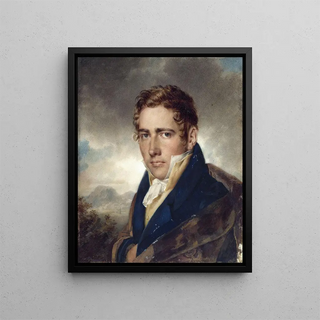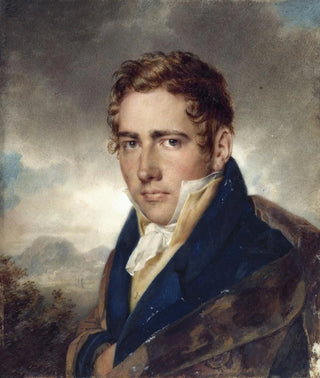Art print | Presumed portrait of architect Auguste Constantin 1790-1842 - Alexandre-Évariste Fragonard


View from behind

Frame (optional)
Portrait of the architect Auguste Constantin 1790-1842 - Alexandre-Évariste Fragonard – Captivating introduction
In the vast panorama of art history, certain works stand out for their ability to capture not only the physical appearance of an individual but also their essence, era, and role in society. The presumed portrait of architect Auguste Constantin, created by Alexandre-Évariste Fragonard, is part of this tradition. This artwork, painted at a pivotal time in French history, evokes a period of upheaval and renewal, where architecture and art intertwine to shape a new urban face. By admiring this portrait, the viewer is invited to delve into the fascinating world of early 19th-century architecture while discovering the complex personality of Constantin, a man whose work contributed to transforming Paris.
Style and uniqueness of the work
Fragonard's style in this portrait is characterized by delicacy and precision, demonstrating his skill in playing with light and shadow. The subtly chosen color palette evokes an atmosphere that is both gentle and dynamic, where each nuance seems to tell a story. The details of Auguste Constantin's costume, carefully rendered, reveal not only the social status of the architect but also a certain elegance that defines the era. The subject's posture, slightly turned to the right, gives an impression of movement, as if Constantin is about to stand up to share his innovative ideas. This portrait does not merely depict a man; it immortalizes a spirit, that of a visionary architect whose contributions have marked the architectural landscape of his time.
The artist and his influence
Alexandre-Évariste Fragonard, grandson of the famous painter Jean-Honoré Fragonard, managed to forge a unique artistic identity within a milieu where the shadow of his ancestor was omnipresent. His training and diverse influences, ranging from neoclassicism to a more romantic style, allowed him to develop a distinctive approach, blending rigor and sensitivity. Fragonard excelled not only in portraiture but also left an indelible mark

Matte finish

View from behind

Frame (optional)
Portrait of the architect Auguste Constantin 1790-1842 - Alexandre-Évariste Fragonard – Captivating introduction
In the vast panorama of art history, certain works stand out for their ability to capture not only the physical appearance of an individual but also their essence, era, and role in society. The presumed portrait of architect Auguste Constantin, created by Alexandre-Évariste Fragonard, is part of this tradition. This artwork, painted at a pivotal time in French history, evokes a period of upheaval and renewal, where architecture and art intertwine to shape a new urban face. By admiring this portrait, the viewer is invited to delve into the fascinating world of early 19th-century architecture while discovering the complex personality of Constantin, a man whose work contributed to transforming Paris.
Style and uniqueness of the work
Fragonard's style in this portrait is characterized by delicacy and precision, demonstrating his skill in playing with light and shadow. The subtly chosen color palette evokes an atmosphere that is both gentle and dynamic, where each nuance seems to tell a story. The details of Auguste Constantin's costume, carefully rendered, reveal not only the social status of the architect but also a certain elegance that defines the era. The subject's posture, slightly turned to the right, gives an impression of movement, as if Constantin is about to stand up to share his innovative ideas. This portrait does not merely depict a man; it immortalizes a spirit, that of a visionary architect whose contributions have marked the architectural landscape of his time.
The artist and his influence
Alexandre-Évariste Fragonard, grandson of the famous painter Jean-Honoré Fragonard, managed to forge a unique artistic identity within a milieu where the shadow of his ancestor was omnipresent. His training and diverse influences, ranging from neoclassicism to a more romantic style, allowed him to develop a distinctive approach, blending rigor and sensitivity. Fragonard excelled not only in portraiture but also left an indelible mark






